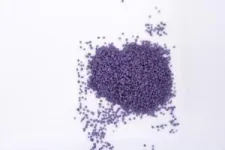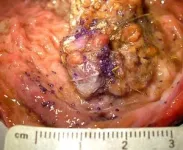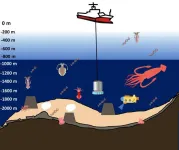(Press-News.org) A recent comprehensive assessment on the poisoning of raptors across Europe does not yield good news. This is according to the new paper “Poisoning in Europe Between 1996 and 2016: A Continental Assessment of the Most Affected Species and the Most Used Poisons,” published in the Journal of Raptor Research. A large team of raptor researchers amassed retrospective data on poisoning events across 22 European countries between 1996 and 2016. Carbofuran and aldicarb were the most common toxins reported and disproportionately affected scavenging raptors, especially in Northern Europe. As high-level participants in trophic interactions and providers of ecosystem services, raptors are crucial agents of Europe’s ecological health. These poisonings are, therefore, troubling. They are also illegal.
Poison is a well-known threat to raptor populations globally and every region has its star culprits: in the tropics, it’s veterinary drugs like diclofenac and the insecticide carbofuran. In temperate zones, rodenticides. In Europe, however, there hasn’t been a continent-wide assessment of illegal raptor poisoning events — until now.
Lead author Ralph Buij, from The Peregrine Fund, and 32 coauthors, invited raptor conservationists, toxicologists, and experts from wildlife forensic networks across the continent to submit their data on raptor poisoning events from 1996 and 2016. The team crunched the resulting dataset through multiple lenses including seasonality, species diet, whether poisonings resulted from single or multiple toxins, and whether poisoning occurrence changed over the course of the study period, including after European trade bans on relevant toxins.
Their results were sobering. A total of 3,196 poisoning events were reported, comprising 37 raptor species. Of these, six are Threatened according to the International Union for the Conservation of Nature’s 2024 status report, including the Saker Falcon (Falco cherrug). Four are Vulnerable, three are Near Threatened, including the Bearded Vulture (Gypaetus barbatus), and 15 have globally decreasing populations. The most commonly poisoned species overall was the Eurasian Buzzard (Buteo buteo), also Europe’s most common and widespread raptor. Carbofuran, aldicarb, parathion, and alpha-chloralose were the four most commonly detected poisons, the first three of which are pesticides that were banned by the European Union (EU) during the first half of the study’s timeframe.
Reasons for poisoning vary but include deliberate targeting of raptor species that are considered a threat to agricultural interests or game hunting. These poisonings usually occur through illegal placement of poisoned baits. Sometimes the baits are intended for other predators like foxes, yet result in raptor deaths through the scavenging process. Peak seasonality for reported poisoning events occurred in early spring, a result likely related to the timing of agricultural activities, game protection, and the onset of hunting efforts. Unfortunately, spring is the same season during which most raptors begin nesting activities. Raptors have long life spans, raise relatively few young, and don’t breed until later in life. All of these life history traits make deaths of breeding adults alarming from a demographic lens.
More than half of the carbofuran and aldicarb poisonings reported in this study occurred after the substances were banned from use in Europe, which points to a pervasive continent-wide issue of illegal application. In the Mediterranean, poisonings are thought to be responsible for more than half the total raptor mortalities and local extirpations. Taken as a snapshot, this underscores the role that poisoning can play in the death of raptors at various scales. Both Buij and coauthor Ngaio Richards are concerned by their assessment’s results. “I just keep wondering how much longer any of these populations can sustain such losses,” says Richards.
When asked what gives him hope about the future reduction of poisoning events, Buij says “where efforts have been increased to address the threats of poisoning, the results have been impressive.” Members of the team point to the LIFE Nature program of the EU as key for many projects and stakeholders in the fight against poisoning. They also laud Spain, which has implemented training of law enforcement officers and government experts, as well as a specialized Canine Unit to reduce poisoning events. “It really is a matter of committing resources to support not just a central system for data gathering,” says Buij, “but also anti-poaching and surveillance activities, enforcement and tougher penalties for the possession of poisons, and improved communications and awareness activities.” Richards adds that in her view, identifying potential or active poisoners within a community and enlisting them as allies can be more effective than employing exclusively punitive measures.
The authors encourage future focus on common and widespread species like the Eurasian Buzzard as early indicators of poisoning problems, as well as concentrated research on the ecosystem services provided by raptors across Europe as a way of documenting the tangible consequences of allowing this issue to persist. Raptors provide free, underappreciated services like removing rotting biomass and regulating prey populations. “I want to see more resources allocated to reviled species and to so-called common species which are currently the most visible face of poisoning,” says Richards. She also notes the importance of studying how poisons affect raptor prey. Collectively, the team emphasizes the need for more routine, standardized monitoring of poisonings for all raptor species across the continent, not just those that are endangered.
###
Paper
Buij et al. (2025). Raptor Poisoning in Europe Between 1996 and 2016: A Continental Assessment of the Most Affected Species and the Most Used Poisons. Journal of Raptor Research, 59(2): 1-19.
DOI: 10.3356/jrr2373
Notes to Editor:
1. The Journal of Raptor Research (JRR) is an international scientific journal dedicated entirely to the dissemination of information about birds of prey. Established in 1967, JRR has published peer-reviewed research on raptor ecology, behavior, life history, conservation, and techniques. JRR is available quarterly to members in electronic and paper format.
2. The Raptor Research Foundation (RRF) is the world’s largest professional society for raptor researchers and conservationists. Founded in 1966 as a non-profit organization, our primary goal is the accumulation and dissemination of scientific information about raptors. The Foundation organizes annual scientific conferences and provides competitive grants & awards for student researchers & conservationists. The Foundation also provides support & networking opportunities for students & early career raptor researchers.
END
A University of Florida researcher has developed a groundbreaking open-source computer program that uses artificial intelligence to analyze videos of patients with Parkinson's disease and other movement disorders. The tool, called VisionMD, helps doctors more accurately monitor subtle motor changes, improving patient care and advancing clinical research.
Diego Guarin, Ph.D., an assistant professor of applied physiology and kinesiology in UF’s College of Health and Human Performance, created the software to address the potential risk of inconsistency ...
Dr. Latifur Khan, professor of computer science at The University of Texas at Dallas, has been elected to the 2024 class of American Association for the Advancement of Science (AAAS) fellows.
Khan is one of 471 scientists, engineers and innovators to be recognized across 24 disciplinary sections. The new fellows will be honored at a June 7 event in Washington, D.C.
The AAAS elected Khan in the section on information, computing and communication for “distinguished contributions to the field of machine learning with applications to cybersecurity, social sciences ...
Dancing fluidly with another involves social coordination. This skill entails aligning movements with others while also processing dynamic sensory information, like sounds and visuals. In a new JNeurosci paper, Félix Bigand and Giacomo Novembre, from the Italian Institute of Technology, Rome, and colleagues report their findings on how the brain drives social coordination during dance.
The researchers recruited pairs of inexperienced dancers and recorded their brain activity, whole-body movements, and ...
A recent study has uncovered a potential breakthrough in treating osteonecrosis of the femoral head (ONFH), a debilitating bone disease that causes severe pain and joint collapse. Researchers have discovered that exosomes derived from M2 macrophages-derived exosomes (M2-Exos) can significantly improve bone regeneration by modulating neutrophil extracellular traps (NETs) and endothelial cell function. These tiny vesicles, packed with miR-93-5p, were shown to reduce harmful NETs formation and enhance ...
New DNA probes allow for efficient surveying of the hidden lives of squids and octopuses in the deep sea. This development by Kobe University provides an effective tool for marine ecological research and conservation efforts.
Squids and octopuses eat and are eaten, and in between that they move around a lot. “Cephalopods play an important role in marine ecosystems, contributing to the distribution of energy and nutrients in the food web,” explains Kobe University marine ecologist WU Qianqian. And while for ecological research it is therefore essential to know about the distribution ...
Patients with depression who received the Moodivate app saw clinically meaningful reductions in their symptoms that were twice those achieved with standard-of-care therapy in a clinical trial conducted at 22 primary care practices in Charleston, South Carolina. App users were also 3 times more likely to achieve a clinically meaningful improvement in their depression and 2.3 times more likely to attain depression remission. Moodivate (available on both iOS and Android) is a digital version of behavioral activation, a type of behavioral therapy that has proved effective against depression. Jennifer Dahne, Ph.D., professor in the Department of Psychiatry and Behavioral ...
Ottawa, ON, April 14, 2025 – Individuals with an emergency department (ED) visit or hospitalization due to cannabis were at 23% and 72% greater risk of a new dementia diagnosis within five years compared to individuals with an ED visit or hospitalization for any other reason or the general population, according to a new study published in JAMA Neurology.
“Long-term and heavy cannabis use has been associated with memory problems in midlife along with changes in brain structure associated with dementia,” says Dr. Daniel Myran, a Canada Research Chair in Social ...
The immune system must be able to quickly attack invaders like viruses, while also ignoring harmless stimuli, or allergies can result. Immune cells are known to ignore or “tolerate” molecules found on the body’s own healthy cells, for instance, as well as nonthreatening substances from outside the body like food. How the system achieves the latter has been unclear.
Now, a new study led by researchers at NYU Langone Health has revealed that a special group of cells in the intestines tamp down the immune responses caused by exposure to food proteins. ...
About The Study: This study found that at current utilization and radiation dose levels, computed tomography examinations in 2023 were projected to result in approximately 103,000 future cancers over the course of the lifetime of exposed patients. If current practices persist, computed tomography-associated cancer could eventually account for 5% of all new cancer diagnoses annually.
Corresponding Author: To contact the corresponding author, Rebecca Smith-Bindman, MD, email rebecca.smith-bindman@ucsf.edu.
To access the embargoed study: Visit our For The Media website at this link https://media.jamanetwork.com/
(doi:10.1001/jamainternmed.2025.0505)
Editor’s ...
About The Study: The findings of this cohort study suggest that the incidence of pancreatic adenocarcinoma has increased among all age groups, whereas that of colorectal adenocarcinoma has increased among younger age groups. Clinicians should be aware of this trend when evaluating younger patients with relevant symptoms.
Corresponding Author: To contact the corresponding author, Arvind J. Trindade, MD, email arvind.trindade@gmail.com.
To access the embargoed study: Visit our For The Media website at this link https://media.jamanetwork.com/
(doi:10.1001/jamanetworkopen.2025.4682)
Editor’s Note: Please see the article for additional ...






